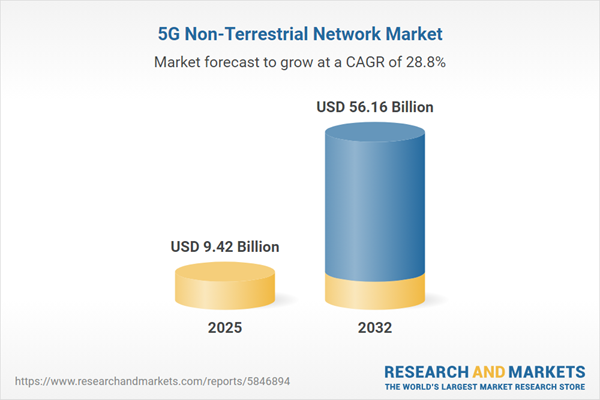Speak directly to the analyst to clarify any post sales queries you may have.
The 5G Non-Terrestrial Network Market is evolving rapidly as organizations demand seamless, resilient connectivity across remote and challenging environments. Senior executives seeking clear direction on emerging supply chain risks, technology shifts, and strategic growth areas will find actionable intelligence in this report.
Market Snapshot: 5G Non-Terrestrial Network Market Overview
The 5G Non-Terrestrial Network Market grew from USD 7.41 billion in 2024 to USD 9.42 billion in 2025. It is expected to continue growing at a CAGR of 28.79%, reaching USD 56.16 billion by 2032. This robust growth is propelled by the integration of satellite, high-altitude, and airborne platforms with terrestrial infrastructure, addressing the escalating demand for persistent connectivity in diverse operating environments. The market’s expansion is characterized by ecosystem partnerships, regional capacity investments, and adoption by industries dependent on uninterrupted, global coverage.
Scope & Segmentation of the 5G Non-Terrestrial Network Market
This research offers comprehensive coverage across all key layers and operational models in the 5G Non-Terrestrial Network value chain, focusing on advancements and adoption drivers at both component and application levels.
- Offering: Components & platforms (gateway stations, ground antennas, high-altitude platforms, satellites across geosynchronous, medium-earth, and low-earth orbits, unmanned aerial vehicles), software solutions, services including consulting, training, system integration, maintenance, managed operations.
- Location: Remote or isolated regions, rural, suburban, and urban environments.
- Frequency Band: C, Ka, Ku, and S bands.
- End User: Aerospace and defense, government, maritime, and mining industries.
- Application: Backhaul connectivity, broadcasting, emergency services, mobile broadband, massive machine-type communications, remote monitoring, vessel tracking, ultra-reliable low-latency communications.
- Geography: Americas (United States, Canada, Mexico, Brazil, Argentina, Chile, Colombia, Peru), Europe, Middle East & Africa (including United Kingdom, Germany, France, Russia, Italy, Spain, Netherlands, Sweden, Poland, Switzerland, UAE, Saudi Arabia, Qatar, Turkey, Israel, South Africa, Nigeria, Egypt, Kenya), Asia-Pacific (China, India, Japan, Australia, South Korea, Indonesia, Thailand, Malaysia, Singapore, Taiwan).
- Technology & Market Participants: Envelope includes leading firms such as Airbus Group, Anritsu Corporation, EchoStar, Eutelsat Communications, Gatehouse Satcom, Iridium, Keysight Technologies, Media Tek, Nelco, Nokia, Omnispace, Qualcomm, Radisys, Rode & Schwarz, Samsung Electronics, Sateliot, SES, Skylo, SoftBank, Spirent Communications, Ericsson, Thales Group, Lockheed Martin, Viasat, ZTE.
Key Takeaways for Senior Decision-Makers
- 5G non-terrestrial networks are critical for enabling persistent high-speed connectivity in locations beyond the reach of traditional cellular infrastructure.
- Integration of satellite constellations, high-altitude platforms, and ground stations delivers multi-layered redundancy, enhancing service continuity for essential operations.
- Edge computing and software-defined networking are streamlining network orchestration, bringing flexibility and efficiency to bandwidth allocation and service provisioning.
- Strategic partnerships and industry consortia drive standardization, interoperability, and deployment acceleration across heterogeneous infrastructure assets.
- Substantial investments by both public and private sectors are bridging digital divides and fueling innovation, especially in underserved and disaster-prone regions.
- Regulatory differences and varying adoption rates across regions require tailored strategies for compliance, market entry, and technology deployment.
Tariff Impact: U.S. Policy Shift
The introduction of new U.S. tariffs on imported satellite components and high-altitude platform hardware is reshaping procurement and manufacturing strategies within the 5G non-terrestrial network supply chain. To mitigate rising costs and supply risks, companies are shifting assembly operations domestically, building local supplier relationships, and renegotiating purchase agreements. Service providers are responding with revised pricing models while seeking to protect investment in innovation and maintain competitive differentiation in service offerings.
Methodology & Data Sources
The market analysis is based on in-depth interviews with senior executives, coupled with robust secondary research from technical publications, regulatory reports, and financial disclosures. Analytical models and expert validation panels ensured accuracy, supporting reliable forecasting and actionable insights for stakeholders.
Why This Report Matters: Value for Senior Leaders
- Offers a strategic roadmap for navigating evolving tariffs, regulatory frameworks, and supply chain disruptions specific to the 5G non-terrestrial network sector.
- Equips business and technology leaders with segmentation insights and technology adoption trends for market entry, partnership selection, and investment prioritization.
Conclusion
The evolution of 5G non-terrestrial networks will enable new levels of global connectivity, resilience, and service innovation. Senior executives using this report can make informed decisions, effectively manage risk, and capture growth opportunities in a complex, dynamic market landscape.
Additional Product Information:
- Purchase of this report includes 1 year online access with quarterly updates.
- This report can be updated on request. Please contact our Customer Experience team using the Ask a Question widget on our website.
Table of Contents
3. Executive Summary
4. Market Overview
7. Cumulative Impact of Artificial Intelligence 2025
Companies Mentioned
The companies profiled in this 5G Non-Terrestrial Network market report include:- Airbus Group, Inc.
- Anritsu Corporation
- EchoStar Corporation
- Eutelsat Communications S.A.
- Gatehouse Satcom A/S.
- Iridium Communications Inc.
- Keysight Technologies
- Media Tek Inc.
- Nelco Limited
- Nokia Corporation
- Omnispace, LLC
- Qualcomm Technologies, Inc.
- Radisys Corporation
- Rode & Schwarz GmbH & Co KG
- Samsung Electronics Co., Ltd.
- Sateliot S.L.
- SES S.A.
- Skylo Technologies, Inc.
- SoftBank Group Corporation
- Spirent Communications
- Telefonaktiebolaget LM Ericsson
- Thales Group
- The Lockheed Martin Corporation
- Viasat, Inc.
- ZTE Corporation
Table Information
| Report Attribute | Details |
|---|---|
| No. of Pages | 183 |
| Published | November 2025 |
| Forecast Period | 2025 - 2032 |
| Estimated Market Value ( USD | $ 9.42 Billion |
| Forecasted Market Value ( USD | $ 56.16 Billion |
| Compound Annual Growth Rate | 28.7% |
| Regions Covered | Global |
| No. of Companies Mentioned | 26 |









